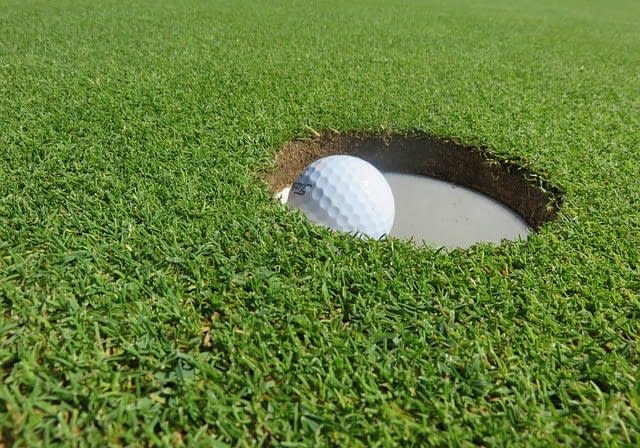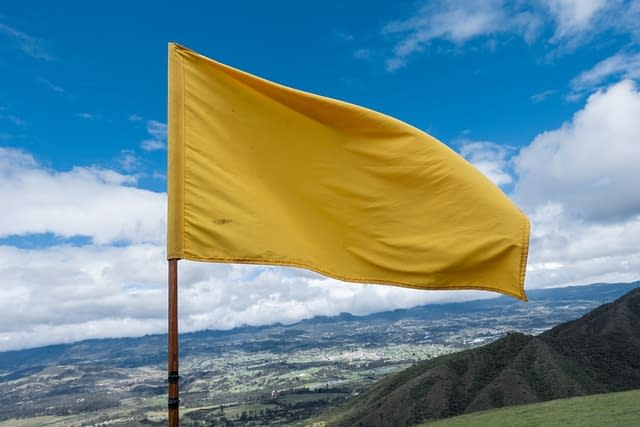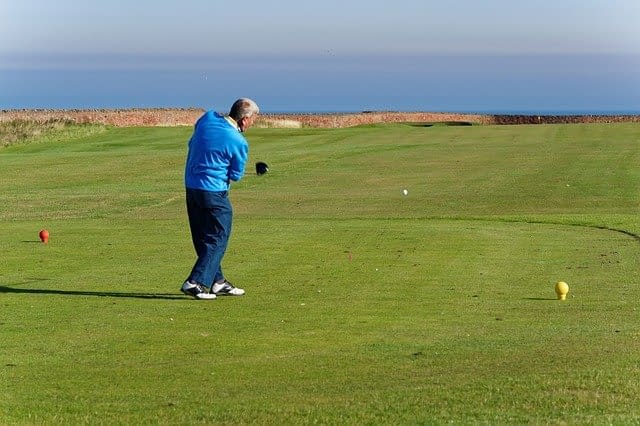- Life & Culture
Golf In Japan & Tokyo – Courses & Costs
Ever wondered what it’s like playing golf in Japan?
Well… it’s incredible.
It may come as a surprise to some, but golf is one of the most popular sports in Japan. As a country, Japan is home to the second most golf courses in the world.
With around 2,350 golf courses across the nation, they’re only outnumbered by the Golf Mecca that is the U.S.
In fact, half of the golf courses in the whole of Asia are in Japan.
Japan is renowned for its dramatic geography and natural beauty. So it’s only right they have some outstanding golf courses too.
With so many Japanese golf courses to choose from, there’s something for every skill level and budget.
If you’re thinking of visiting or working in Japan, it won’t be hard to find a golf course. But, before you dive in, read this post to find out everything you need to know about playing the hardest game of the world in the land of the rising sun.

Golf in Japan rules and differences
While the same basic rules of golf are the same in Japan as they are anywhere else in the world, there are a few differences that you should be aware of, including:
Scoring a hole in one
Scoring a hole in one in Japan can cost you a lot of money.
You will be expected to buy expensive gifts, pick up the green fees and pay for dinner and drinks for all your playing partners.
This can be very pricey. As such, people commonly take out hole in one insurance to cover the costs.

Yellow flags
You will often notice a yellow flag placed on the fairway. This indicates where a good tee shot should land.
If you are behind a group that has moved past the yellow flag, you are usually safe to tee off. However, if you’re a big hitter, it’s probably best to wait until they’re further away.

OB tees
In order to speed up play on holes where out of bounds shots are common, there are out of bounds tees (forward tees).
These are usually located where a good tee shot should have landed.
If you play a ball out of bounds (usually marked by white stakes along the hole) or into the water on your initial shot, you will take your next shot from the OB tee.
One penalty stakes
When you are on the golf course in Japan, you are also likely to see yellow or black and yellow striped stakes. These are one penalty stakes, and they represent different rules to normal out of bounds markers.
If your ball crosses one of these boundaries, you will incur a one-shot penalty and must take your next shot from around the area where your ball crossed the boundary. The drop can be within two club lengths of the point of crossing but no closer to the hole.
Blue Stakes
Blue stakes mark an area where the ground is being repaired. This area will also be accompanied by a chalk border in most cases.
If your ball lands in one of these areas, you can lift it up and drop it at the nearest point outside the chalk marked zone.
Double greens
Japan has very extreme seasons. To ensure the greens remain playable all year round, a double green system was introduced and has become commonplace. The greens used to have different types of grass on them too. This was usually bermuda or zoysia for the summer greens and bent grass for the winter greens.
As advancements in turf management have been made, the need for different types of grass has been reduced. But, having two greens is still a great way to prevent excessive wear and tear, which is why many courses still opt to keep them.

Golf carts
On most golf courses in Japan, you will be expected to use a golf cart. Carts are included in green fees. But, you can walk if you like. Most of the courses have remote control carts too, so it is possible to walk whilst your cart carries your clubs.

9th hole lunch
When playing golf in Japan, it is common to stop for a one-hour lunch break after the 9th hole. After you’ve finished up on the 9th hole, you will head back to the clubhouse for a delicious Japanese lunch. You will be given a tee off starting time for the 10th tee whilst you’re there.
Dip in the hot spring to finish your game?
It’s not uncommon to find a hot spring bath in the clubhouse. Sounds great, right! There’s nothing better than soaking away your aches and pains in a warm onsen after a long walk around an 18 hole course.

Dress code
Most golf courses in Japan have at least some level of appropriate dress code that they would like you to respect. Public courses are usually more relaxed than private courses though.
The rules seem to be getting less strict as golf courses are evolving and trying to cater to the needs of modern young players.
However, the level of dress code depends on which course you are visiting. Make sure to check this before you rock up in blue jeans or a mini skirt.
One thing is very important. Clean your shoes. Japanese golfers are meticulously clean, and there are dedicated shoe cleaning areas in most clubs.
Language barriers
One of the biggest challenges you will probably face when golfing in Japan is the language barrier.
Once you start trying to make reservations, you will soon realise that most golf club staff do not speak English. Everything in writing will probably only be in Japanese too.
So, before you go golfing, you should try to brush up on some basic Japanese language skills, book through a travel agent/hotel or find a foreigner-friendly course to play at.

How much does it cost to play golf in Japan?
Just like golf courses anywhere else in the world, the prices vary depending on the club.
The very best courses usually require a membership and often charge astronomical fees.
However, more and more courses are opening to the public, meaning you can play a game at a reasonable price.
While prices vary massively, for playing golf in Tokyo, you should expect to pay between 15,000 yen – 20,000 yen on a weekend and 8,000 yen – 12,000 yen on a weekday.
Top 10 golf clubs in Japan
Now you know a little about the differences between playing golf in Japan, here are 10 of the best courses in Japan. They’re definitely worth a visit if you can get in.

1. Hirono
Founded in 1932, Hirono is possibly the most important golf club in Japan. It has been host to all of Japan’s major golf tournaments.
Although it is relatively short, the course is a tremendous test of skill. However, being one of the most exclusive clubs in the country, you may struggle to get a game here.
2. Oarai
Oarai is undoubtedly one of the best golf courses in Japan. This club is private, and you will need to be a member or at least be invited by a member to play a game here.
If you do manage to obtain an invite, the seaside course promises a great game of golf with spectacular views of the ocean. The strong ocean winds can make this course quite unpredictable though.

3. Kawana (Fuji)
Opened in 1936, this famous Japanese golf course combines stunning natural beauty with an excellent round of golf.
The well-maintained course meanders along the coastline, providing breathtaking 360 views every few holes. Fees are fairly expensive, but it’s definitely worth it for the experience.
4. Ono
Ono golf club is located about an hour’s drive away from Kobe. It is often regarded as the sister club of Hirono.
Set on a hill and surrounded by stunning landscapes, including lots of trees and several ponds, the course feels like a beautiful Japanese garden.

5. Naruo
Naruo is one of the oldest golf courses in Japan. This classic golf club was originally founded by British expats in 1920.
In the 1930s, it was redesigned with input from the famous C.H Alison. Providing interesting landscapes and a great round of golf, it’s definitely worth a visit.
6. Kasumigaseki (East)
A hotspot for playing golf in Tokyo, The Kasumigaseki Country Club was founded in 1929.
It’s actually located on the same grounds as Tokyo Golf Club and was even used as the course for the 2021 Tokyo Olympics golf games.
In preparation, it was completely renovated in 2016, with an additional 500 yards being added to the course. This is a course that makes use of the dual green system mentioned above.

7. Tokyo Golf Club
Thinking of playing golf in Tokyo? Founded in 1913, the Tokyo Golf Club has moved twice to reach its current location.
Possibly the most famous of the Tokyo golf courses, the members-only golf club is located around an hour and a half outside of the city centre.
It is a very prestigious club, and if you want to play here, you will need to be invited. If you are lucky enough to get an invite, it’ll definitely be a game to remember.
8. Abiko
Located 35 miles North East of Tokyo, Abiko Golf Club was founded in 1930. Since its opening, it has been one of the most famous courses in Japan. It’s been host to big competitions, including the Japan Open Golf Championship.

9. Yokohama (West)
Founded in 1960, Yokohoma Country Club is located around 40km south of Tokyo. Whilst the east course is open to the public, the west course is only open to members and their guests.
The west course features a 19th hole. It’s a small par three on the way back to the clubhouse that’s designed to settle bets when games are tied at the end of the 18th hole.
10. Koga
Around 20 miles north of Fukuoka lies Koga golf club. It was built when the Nishi-Nippon Railway Corporation made a portion of coastline land available to build a golf course.
Located between the city of Koga and the Genkainada sea, it’s another gorgeous 18 hole course with stunning seaside views.

A brief history of golf in Japan
Golf in japan was introduced in 1903 by a group of British Expats. They established the first golf course at Kobe.
In 1913 a group of native Japanese people who had encountered golf in the United States established the Tokyo golf club at Komazawa.
By 1924, seven clubs were in existence, and the Japan Golf Association was established. With the popularity of golf in Japan, more clubs started springing up all over the country.
However, the great depression, an anti-western attitude and war limited the growth of the sport. During the war, some courses were requisitioned for use by the military or used as farmland.
After WW2, Japan’s golf courses were controlled by the United States, who were occupying the country at the time. After 1952, the occupying forces began to leave Japan and returned their golf courses to Japanese control.
By the year 1956, Japan had 72 golf courses.
As Japan experienced their period of economic growth, more and more golf courses were opened across the country. Golf was very popular amongst business people who would take clients for luxurious games of golf and fancy meals as a way to build relationships.
By 1964, there were 424 courses. In the early 70s, there were over 1,000 courses, and now there are almost 2,350.

Will you be playing golf in Japan?
Now you know about golf in Japan and some of the best courses, do you think you’ll be playing a game?
If you’re thinking about teaching in Japan, we’re sure you’ll have some time for a game on the weekend, especially if you make any important connections at a private school. Why not apply to be a teacher in Japan today.
